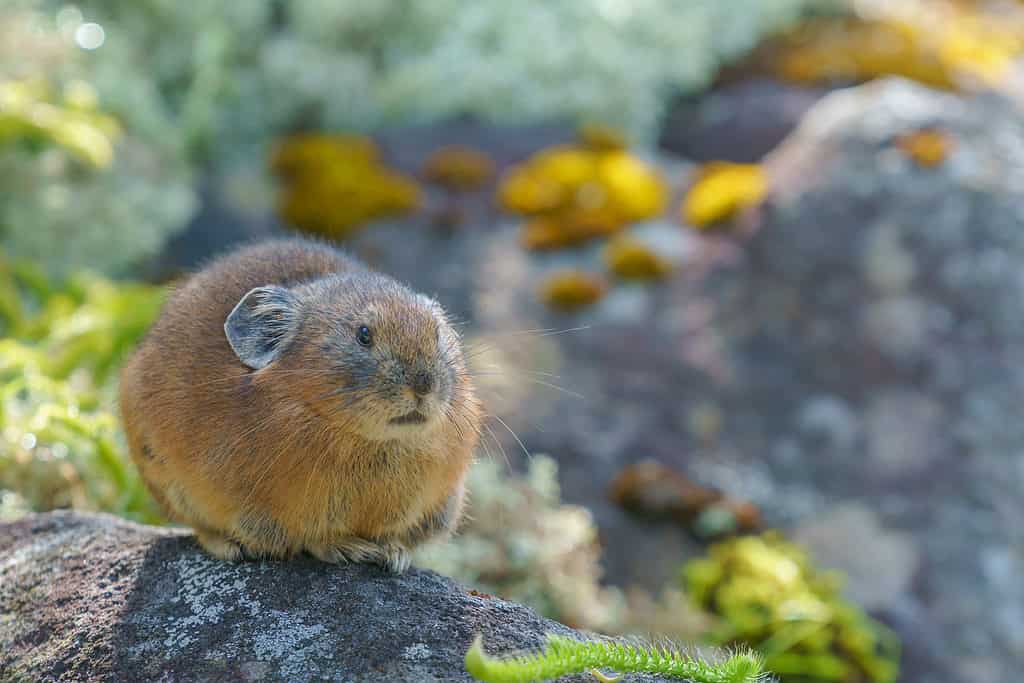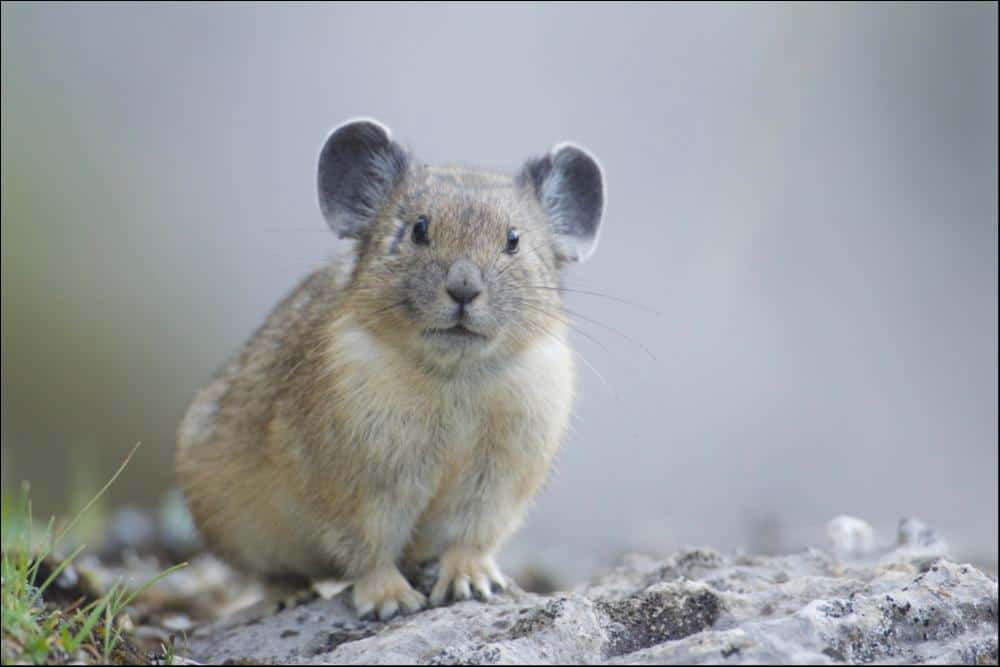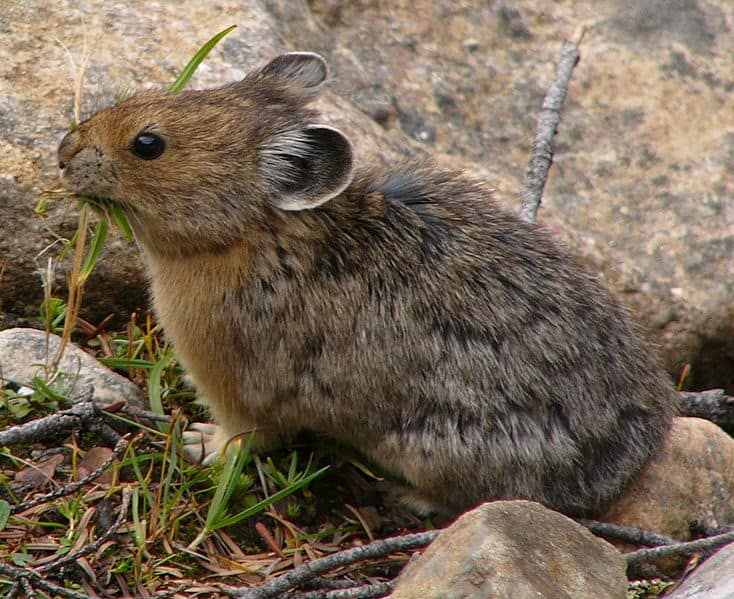Pika
Ochotona Minor
Found in mountainous regions and rocky areas
Advertisement
Pika Scientific Classification
- Kingdom
- Animalia
- Phylum
- Chordata
- Class
- Mammalia
- Order
- Lagomorpha
- Family
- Ochotonidae
- Genus
- Ochotona
- Scientific Name
- Ochotona Minor
Read our Complete Guide to Classification of Animals.
Pika Conservation Status
Pika Facts
- Main Prey
- Grasses, Weeds, Thistles
- Habitat
- Mountainous areas
- Predators
- Weasel, Eagle, Dogs
- Diet
- Herbivore
- Average Litter Size
- 3
Parts of the Northern Hemisphere are home to the Pika. Even though they resemble a rat, their closest relatives in the animal kingdom are hares and rabbits. One of the ways you can tell you are looking at a Pika is that they don’t have tails. Their bodies are small and round.
At Rocky Mountain National Park, Pika live up high in the trees. The park is one of the few places on Earth where two subspecies of the animal are found. One of those species calls the southern hemisphere home while the other one calls the northern hemisphere home.
Four Pika Top Facts
- The American Pika represents climate change
- Pika is an animal that is closely related to the rabbit
- Pika prefers solitude to company
- They warn each other of predators nearby

Scientific Name
The scientific name of the Pika is Ochotona Minor. It is part of the Mammalia class and the Ochotinade family. American Pikas are a part of the lagomorph group and are also its smallest members.
The word Pika dates back to the years between 1820 and 1830. A German naturalist used it to describe the noise made by the Russian Pika, which means to squeak. Since Pikas make a sound that is shrill, the word is used to describe the animal.
Appearance & Behavior

Pikas’ thick coat of fur means they are unable to withstand elevated temperatures during a prolonged period
©stock_shot/Shutterstock.com
A Pika’s body is small and short. It has large, round ears. The average Pika is seven or eight inches long. In comparison, a bowling pin is twice as tall as a Pika. They weigh between 2.6 oz and 10 ounces, making them about the same weight as a hamster.
Either black or brown in color, a Pika has thick fur so that they don’t get cold during the winter months. The dark color of their fur helps them blend in with the rocks found in their natural surroundings.
When the weather warms up a Pika’s coat of fur thins out so they don’t get too hot in the sun. However, in extreme heat, their fur is still thick enough that they may suffer.
Pikas are animals that live close to each other and in colonies. Within their colonies, each one has its own den. They warn each other if a predator is nearby and alert each other by whistling. This is the reason that Pikas have large ears.
Evolution
As lagomorphs, pikas are cousins to hares and rabbits, even though it may not seem like it at a first glance. That is due to the fact that they belong to the order Ochotonidae while the latter belong to the family Leporidae, both of which form the order Lagomorpha.
Their evolution as part of the order is shrouded in mystery. However, scientists have recently come to believe that they are the descendants of the Anagaloidea which lived between 56 – 66 million years ago during the Paleocene Era. As a result, they may also be considered to be the distant relatives of elephant shrews.
The ancestors of pikas, however, appeared in Asia during the Eocene between 34 – 66 million years ago and the Oligocene, between 23 – 34 million years ago. Pikas are generally divided into burrowers which are highly social, and rock dwellers which are territorial.
Types
There are 34 species of pikas including:
- American pika (O. princeps): Medium-sized as far as pikas go, this species has a maximum length of 8.5 inches. Towards the southern range of its habitat, it can be found at elevations of 8,200 feet.
- Chinese red pika (O. erythrotis): The largest pika subspecies, the rodent is capable of growing to 12 inches. It tends to have a red coat in summer and a grey coat in winter.
- Forrest’s pika (O. forresti): Capable of living at elevations of over 14,000 feet, the rodent is capable of growing to over 7 inches. It can be found in the Himalayas in southwestern China and has a dark coat in summer which lightens to gray in winter.
- Glover’s pika (O. gloveri): Recognizable by its gray-brown coat, this rodent is capable of growing up to 8.7 inches in length. Another species which is endemic to China, it can be found in Sichuan, Tibet, Qinghai, and Yunnan. The small mammal is capable of living at elevations of 5,600 feet and can even be found as high as 13,800 feet.
- Pallas’s pika (O. pallasii): The tiny mammal which has a light-colored coat in summer which darkens in winter, is capable of growing to almost 10 inches and weighing 200 grams. It is found in western Mongolia and is known to play a key role in seed dispersal.
Habitat
There are only certain places in the world where you can find a Pika. They are found in a few places in Europe, Asia, and North America. Mountain meadows are generally located close to where Pikas live, as they often live on cliffs.
Some Pikas live at low altitudes, like those living in California’s Lava Bed National Monument. Other states the Pika lives in are:
- New Mexico
- Montana
- Nevada
- Wyoming
- Utah
- Colorado
- Oregon
- Washington
- Idaho
Pikas can also be found in Western Canada.
Diet

Pikas are herbivorous animals so their diet consists mainly of vegetables. During the day they will hunt for berries and seeds, but also thistles, grass, and weeds. Living in places with rocky mountain formations they collect food over the summer so that they aren’t hungry all winter.
Predators & Threats

Eagles occasionally prey on pikas
©Eleanor Esterhuizen/Shutterstock.com
Since they are so small Pikas like to live away from other animals. But they are still vulnerable to predators. Weasels are their most common threat. Others include cats, birds of prey, foxes, eagles, coyotes, and dogs.
It isn’t just predators that are a threat to the Pika. Increasingly warm weather is decreasing the Pika population. When the outside air temperature is 77 degrees Fahrenheit, Pikas cannot survive longer than six hours. They are in danger of becoming extinct if the world continues to get warmer.
Reproduction, Babies, and Lifespan

Pikas have a gestation period of one month and may give birth to as many as six young
©Sevenstar – Public Domain
The breeding period for Pikas takes place during the earliest part of the spring. It is not unusual for them to have another breeding period during the summer. When they are ready to breed, a Pika animal will stay in one territory and another Pika animal will be in another territory. The two Pikas will call to each other, which starts the process of breeding.
Pikas carry babies inside them for one month before the babies are born. The average size of a litter of Pikas is three. However, they may only have two babies or they may have as many as six.
For the first month of a Pika’s life, they must remain with their mother. By the time they are three months old, they are considered an adult. When they become one year old, they are old enough to breed. The average lifespan of a Pika is six years. However, due to circumstances out of their control some only live for half that amount of time.
Population
Because of global warming, animal activists have been trying to get Pikas declared in danger of extinction. As of 2020, this has not happened. Pikas used to live in 29 different places all over California. Now they only live in 11 of those 29 places. This has caused concern among those who are interested in their well-being.
Pikas used to live in Zion National Park in Utah, but can no longer be found there. While some do still live in The Great Basin (located between Wasatch Mountains, in Utah, and both the Cascade Mountains and the Sierra Nevadas), a study showed that there was 44% fewer Pikas in that area than there used to be. In both Nevada and Oregon, the Pika population is believed to be only 1/3 of what it previously was.
Full Species List
- Afghan pika
- American pika
- Alpine pika
- Chinese pika
- Collared pika
- Daurian pika
- Flat-headed pika
- Forrest’s pika
- Gaoligong pika
- Gansu pika
- Glover’s pika
- Helan Shan pika
- Hoffmann’s pika
- Kazakh pika
- Korean pika
- Manchurian pika
- Moupin pika
- Ili pika
- Koslov’s pika
- Ladak pika
- Large-eared pika
- Nubra pika
- Pallas’ pika
- Plateau pika
- Qionglai pika
- Royle’s pika
- Sacred pika
- Siberian pika
- Sijin pika
- Steppe pika
- Tsing-ling pika
- Turuchan pika
- Turkestan red pika
- Yellow pika
Pika FAQs (Frequently Asked Questions)
Are Pika Dangerous?
Since PIka are not domesticated animals it is not safe to hold them in captivity. They are not used to being near people. A Pika may react negatively when approached by a person.
Can You Get A Pika As A Pet?
No. Pika are not an animal that should be kept as a pet. They need to live in certain conditions that cannot be provided by living in a home with people. A better choice in pets would be an animal related to a Pika, such as a rabbit.
Are Pika Rodents?
As a member of the lagomorph group, a Pika is not a rodent even though many people feel it looks like one. It is a small animal that thrives in conditions rodents do not live in.
Are Pika herbivores, carnivores, or omnivores?
Pika are Herbivores, meaning they eat plants.
What Kingdom do Pika belong to?
Pika belong to the Kingdom Animalia.
What phylum do Pika belong to?
Pika belong to the phylum Chordata.
What class do Pika belong to?
Pika belong to the class Mammalia.
What family do Pika belong to?
Pika belong to the family Ochotonidae.
What order do Pika belong to?
Pika belong to the order Lagomorpha.
What genus do Pika belong to?
Pika belong to the genus Ochotona.
What type of covering do Pika have?
Pika are covered in Fur.
In what type of habitat do Pika live?
Pika live in mountainous areas.
What is the main prey for Pikas?
Pikas prey on grasses, weeds, and thistles.
What are some predators of Pika?
Predators of Pika include weasels, eagles, and dogs.
What is the average litter size for a Pika?
The average litter size for a Pika is 3.
What is an interesting fact about Pika?
Pika are found in mountainous regions and rocky areas.
What is the scientific name for the Pika?
The scientific name for the Pika is Ochotona Minor.
What is the lifespan of a Pika?
Pika can live for 3 to 6 years.
How fast is a Pika?
A Pika can travel at speeds of up to 15 miles per hour.
Thank you for reading! Have some feedback for us? Contact the AZ Animals editorial team.
Sources
- David Burnie, Dorling Kindersley (2011) Animal, The Definitive Visual Guide To The World's Wildlife
- Tom Jackson, Lorenz Books (2007) The World Encyclopedia Of Animals
- David Burnie, Kingfisher (2011) The Kingfisher Animal Encyclopedia
- Richard Mackay, University of California Press (2009) The Atlas Of Endangered Species
- David Burnie, Dorling Kindersley (2008) Illustrated Encyclopedia Of Animals
- Dorling Kindersley (2006) Dorling Kindersley Encyclopedia Of Animals
- David W. Macdonald, Oxford University Press (2010) The Encyclopedia Of Mammals

















